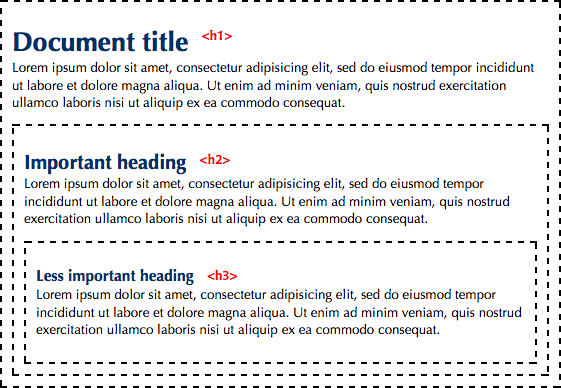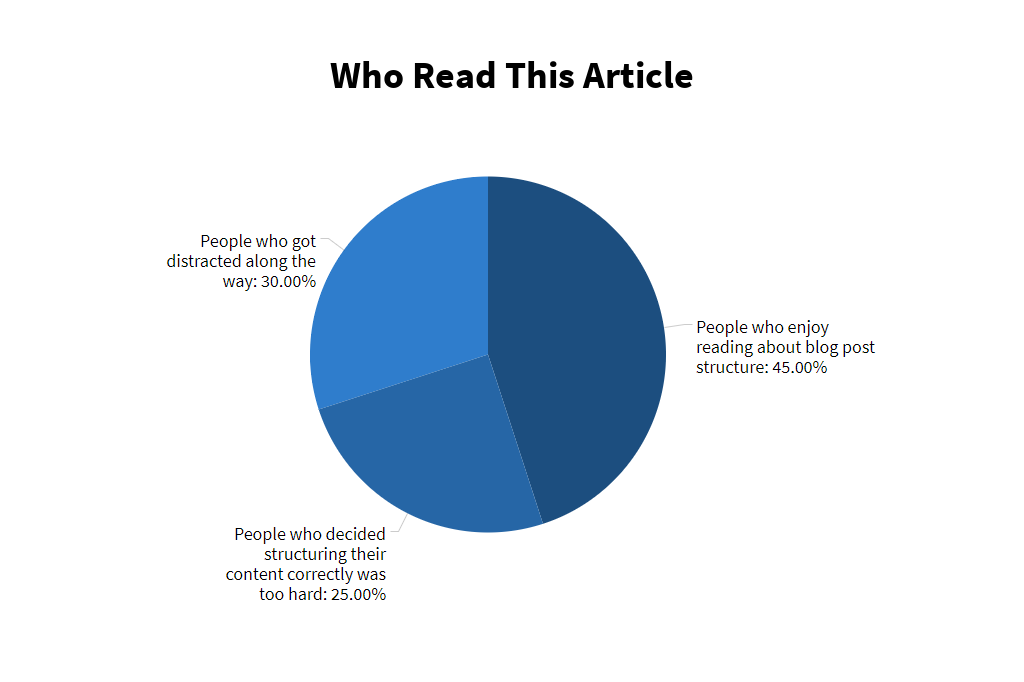Writing a kickass article isn’t rocket science. While a lot of people will argue that it’s all about the content, I beg to differ.
The very best blog posts flow extremely well. They have a solid structure in place that allows the reader to follow the topic in a logical order, or skip ahead to the part that they are interested in.
If this sounds bland, don’t worry. I’m not saying creativity isn’t important. But consider if you are the most creative person in the room — you still need to convey your message effectively.
After all, what good are ideas that can’t be communicated well?
Creating a structure for your blog post lays down the very foundation for your content. It also eliminates a lot of the difficulty and uncertainty that we often face while writing a compelling blog post.
In this article, I’ll walk you through some of the most important elements of a clear blog post structure as well as some tips to help you along the content creation process.
Having a Blog Structure: Why Does It Matter?
A clear structure can help you, your readers, and search engines alike. For starters, you’ll be able to articulate your thoughts and ideas so much better when you have a skeleton of what your post should look like.
It takes a lot of the guesswork out of the writing process, and in my experience, helps to speed it up too.
Instead of spending hours staring at a blank page, you have a list of talking points to begin writing on.

But once you’re done writing, there are more important reasons for structuring your content well. The readability of your blog post becomes better, allowing you to get your message across in a clearer manner.
Oh, and don’t forget about search engines. Despite what Google might tell you, search algorithms are a long way from deeply understanding your content.
A good structure gives search engines a clear insight into what your content is about. It makes their job easier for them, which contributes to better rankings. If you care about organic search traffic (and you should), this is SEO 101 stuff.
Using Keyword Research To Get Started
Before thinking about how to structure your blog post, you need to know what your readers care about. A tried and true approach for myself is via keyword research.
Even if you don’t care too much about SEO, keyword research allows you to understand the topics that relate to what you’re talking about.
They aren’t only useful in telling search engines what your content is about, they act as a foundation for your blog structure. With keyword research you can find out:
- The real intent behind a person’s search, aka “what they are actually looking for”
- Related topics that help you to produce a more detailed post
- Search volume, which tells you how often people search for the term (unless you’re doing it for personal enjoyment, don’t write about things that people aren’t looking for!)
- Questions they have relating to the topic
Keyword research takes you one step closer to a brilliant piece of content. It sheds light on the topics you can talk about, and done correctly can help you to produce the very best article on the topic they are searching for.
Long-Tail Keywords vs. Short Keywords
Keywords can range from single words to phrases and even short sentences. For the purpose of creating a structure, we’re interested in the longer keywords known as “long-tail keywords”.
Why are they so important? Because they give you a better idea about what the reader is looking for.
For example, the keyword how to start a food truck in London tells you a lot more about what the reader is looking for as opposed to only food trucks. If you’re a small business blogger in the UK, that could be a great topic for your next blog post.

Doing this research isn’t complicated, but it can be time-consuming. Tools like Ahrefs and SEMrush are built to save time for you here. If you’re on a budget you can even scroll down to the bottom of every search results page and find Google’s list of automatic keyword suggestions.
Of course, if you want help here, my team over at Dialed Labs offer a keyword research service for busy bloggers like yourself, so you can focus on writing.
How To Create a Clear Structure
Now that you have a list of relevant keywords and topic ideas, you can begin creating the actual structure of your blog post.
Since this is solely a framework for what’s to come, your structure doesn’t have to be super detailed. Your focus should mostly be on creating a layout that includes all the topics you want to talk about within your article.
Here’s a list of everything that goes into creating a great blog structure.
Start Off With a Bang
If your introduction isn’t attention-grabbing, it’s not going to be good enough. Sounds harsh, but that’s the way the internet works.
Remember that your readers go through dozens and dozens of blogs to find the information they need. This leaves you with a few seconds to reel them in and make them want to stay there.
Does this mean you need an over-the-top or dramatic introduction? Far from it. A compelling introduction can be a simple one too. The goal of your introduction is to make the reader think “I’ll get my answer in this article”. It should give them a clear idea about what they’re going to read in your blog post.

Your opening line could be a bold statement, a simple question, or something else entirely. Once you clearly understand what your readers want, you’ll be able to hit the nail on the head.
Short Paragraphs and Even Shorter Sentences
Things can get quite monotonous when you’re writing thousands of words in blog content. Writing long drawn-out sentences won’t make it any easier for your readers to keep up.
With the advent of smartphones most of us can’t concentrate on something for longer than a few seconds without getting distracted.

The solution? Stick to writing short sentences and paragraphs.
They’re not as intimidating as long walls of text. If you’re writing about something complex or detailed — short paragraphs can help you break it down better for your readers too.
I personally prefer paragraphs of around 2-3 sentences. It helps me get the point across clearly without overwhelming my readers.
In a nutshell, save the long sentences and paragraphs — your readers will value simplicity far more.
Break It Up with Headings
By now you must have gathered that reading long blocks of content is nothing less than a chore. Since your primary focus is keeping your readers interested in your content, you’ll want to do everything you can to make the readability easier for them.
Continuing this line of thought brings us to the use of headings, known as:
- H1
- H2
- H3
- H4
- H5 and
- H6 tags
A post should not have more than one H1 tag — this is the main heading that tells Google what the article is about, and most themes on WordPress and other blogs will use this for your post’s title.

Knowing when and where to use the right headings is something that can make or break your content. With the right heading hierarchy, you can drastically change the way your blog post looks, making it appear more organized.
This becomes apparent when you add a “Table of Contents”. Your headings and subheadings are nicely nested within each other, allowing your readers to get a proper understanding of your content.

Use Lists Whenever You Can
The truth is, not everyone will read every last word of your content. Most of the time they’ll prefer skimming through to find the parts they’re interested in.
This is where lists come to the rescue. Lists are a great way to:
- Highlight important points that don’t need their own paragraphs
- Create a flow or sequence (numbered lists come in handy here)
- Break up paragraphs into easily digestible sources of info
See what I did there? 🙂
Using lists helps to break out the monotony that comes with reading continuous paragraphs and walls of text. Your readers will mentally thank you every time you use them.

Pictures (and Videos) Speak Louder Than Words
Just because you’re writing a blog, doesn’t mean there’s no room for other kinds of media. In fact, using images and videos will make your post far more interesting than plain text.
For starters, it gives readers context to what you’re talking about. Let’s say you have a DIY blog for home improvement. Adding images can help your readers better visualize the steps involved in a project.
Maybe you have a marketing blog? Graphs, infographics, charts work really well in this scenario.

For your readers, images are a refreshing break from text. A good blog writer knows this well and doesn’t solely rely on just their written content.
Instead, it’s about creating a balance and finding the right media to support your text. Throw in an infographic, an explainer video, or even a meme if it works.
Summary or Conclusion
The conclusion to your blog post is the perfect way to refresh the mind of the reader, drawing attention to everything they learned through your post.
I’ve seen so many well-written articles that just didn’t give enough importance to writing a conclusion — which is why they failed to leave a long-lasting impression.
It just goes to show that even if you’ve written a stellar blog post, you need to end it on the right note. The absence of a summary or conclusion leaves the reader hanging awkwardly.
It’s like walking down a road only to come to an abrupt dead end.
Give your summary the same kind of importance you give your introduction and take this opportunity to drive your overall point home.
Create a Compelling Call to Action
Chances are if you’ve spent this long writing a blog post, you’re hoping your readers will perform some action after they’re done reading. Maybe you’d like to point them to your paid subscription or ask them to consider buying your services.
A call to action is what we use to urge readers to complete that action. If a reader arrives on your blog post to purchase a product, your call to action needs to be clear and prompt them accordingly.
Some common, and simple calls to action include:
- Leave a comment
- Subscribe to our newsletter
- Follow us on social media
- Visit our online store
The focus lies on creating a clear call to action so you don’t confuse your readers. There’s no need to beat around the bush here, just be direct.

Well Structured Blog Posts Create Value for Readers and Search Engines
Search engines value user experience now more than ever, which means the easier your content is to read — the better your website’s search rankings.
But more important than search rankings, people value easy to read content and will support you when you give them the answers they need.
If you want to leverage blog posts to grow your business or personal profile online, I strongly encourage you to pay attention to the structure you use while writing.
Of course, it doesn’t end there. Your writing should serve a purpose and answer the questions in the mind of the reader. All of these elements ultimately come together and leave you with a blog post that can earn its spot on the top of Google’s search results and shares on social media.
Hungry for more info? Read this guide on how to write blog posts that get results.

I haven’t thought about structure enough in making blogs. I’ve always thought the blog is good enough as long as the content is good enough. Thanks, Jase; I’ll surely incorporate structure into my content going forward.